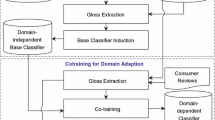Abstract
The Web has become an excellent source for gathering consumer opinions (more specifically, consumer reviews) about products. Consumer reviews are essential for retailers and product manufacturers to understand the general responses of customers to their products and improve their marketing campaigns or products accordingly. In addition, consumer reviews enable retailers to recognize the specific preferences of each customer, which facilitates effective marketing decisions. As the number of consumer reviews expands, it is essential and desirable to develop an efficient and effective sentiment analysis technique that is capable of extracting product features stated in consumer reviews (i.e., product feature extraction) and determining the sentiments (positive or negative semantic orientations) of consumers for these product features (i.e., opinion orientation identification). Product feature extraction is critical to sentiment analysis, because its effectiveness significantly affects the performance of opinion orientation identification, as well as the ultimate effectiveness of sentiment analysis. Therefore, this study concentrates on product feature extraction from consumer reviews. Specifically, we propose a semantic-based product feature extraction (SPE) technique that exploits a list of positive and negative adjectives defined in the General Inquirer to recognize opinion words semantically and subsequently extract product features expressed in consumer reviews. Using a prevalent product feature extraction technique and the SPE-GI technique (a variant of SPE) as performance benchmarks, our empirical evaluation shows that the proposed SPE technique outperforms both benchmark techniques.


Similar content being viewed by others
Notes
Each tag refers to a lexical category. Examples of lexical categories include: determiner (DT), noun, singular and mass (NN), verb, third-person singular present (VBZ), adverb (RB), adjective (JJ), and preposition or subordinating conjunction (IN).
References
Agrawal R, Srikant R (1994) Fast algorithms for mining association rules in large databases. In: Proceedings of 1994 international conference on very large data bases, Santiago, pp 487–499
Dave K, Lawrence S, Pennock DM (2003) Mining the peanut gallery: opinion extraction and semantic classification of product review. In: Proceedings of the 12th international conference on World Wide Web (WWW 2003), Budapest, pp 519–528
Dellarocas C (2003) The digitization of word of mouth: promise and challenges of online feedback mechanisms. Manag Sci 49(10):1407–1424
Duan W, Gu B, Whinston AB (2008) Do online reviews matter? An empirical investigation of panel data. Decis Support Syst 45(4):1007–1016
Etzioni O, Cafarella M, Downey D, Popescu AM, Shaked T, Soderland S, Weld DS, Yates A (2005) Unsupervised named-entity extraction from the Web: an experimental study. Artif Intell 165(1):91–134
Fellbaum C (ed) (1998) WordNet: an electronic lexical database. MIT Press, Cambridge
Forman C, Ghose A, Wiesenfeld B (2008) Examining the relationship between reviews and sales: the role of reviewer identity discloser in electronic markets. Inf Syst Res 19(3):291–313
Godes D, Mayzlin D (2004) Using online conversations to study word of mouth communication. Mark Sci 23(4):545–560
Hu M, Liu B (2004a) Mining and summarizing customer reviews. In: Proceedings of the 10th ACM SIGKDD international conference on knowledge discovery and data mining, Seattle, pp 168–177
Hu M, Liu B (2004b) Mining opinion features in customer reviews. In: Proceedings of American association for artificial intelligence (AAAI) conference, pp 755–760
Jindal N, Liu B (2006) Identifying comparative sentences in text documents. In: Proceedings of the 29th annual international ACM SIGIR conference on research and development in information retrieval, New Orleans, pp 244–251
Kennedy A, Inkpen D (2006) Sentiment classification of movie reviews using contextual valence shifters. Comput Intell 22(2):110–125
Kobayashi N, Inui K, Matsumotto Y (2004b) Collecting evaluative expressions for opinion extraction. In: Proceedings of the first international joint conference on natural language processing (IJCNLP-04), Hainan Island, pp 596–605
Kobayashi N, Iida R, Inui K, Matsumotto Y (2005) Opinion extraction using a learning-based anaphora resolution technique. In: Proceedings of the second international joint conference on natural language processing (IJCNLP-04), Jeju Island, pp 173–178
Liu B, Hu M, Cheng J (2005) Opinion observer: Analyzing and comparing opinions on the Web. In: Proceedings of 2005 World Wide Web (WWW) conference, Chiba, pp 342–351
Popescu A, Etzioni O (2005) Extracting product features and opinions from reviews. In: Proceedings of the conference on human language technology and empirical methods in natural language processing, Vancouver, pp 339–346
Srikant R, Agrawal R (1995) Mining generalized association rules. In: Proceedings of the 1995 international conference on very large data bases, Zurich, pp 407–419
Stone PJ, Dunphy DC, Smith MS, Ogilvie DM (1966) The general inquirer: a computer approach to content analysis. MIT Press, Cambridge
Turney PD, Littman ML (2003) Measuring praise and criticism: inference of semantic orientation from association. ACM Trans Inf Syst 21(4):315–346
Wong TL, Lam W (2005) Hot item mining and summarization from multiple auction Web sites. In: Proceedings of the fifth IEEE international conference on data mining (ICDM’05), Houston
Wong TL, Lam W (2008) Learning to extract and summarize hot item features from multiple auction Web sites. Knowl Inf Syst 14(2):143–160
Yang Y (1999) An evaluation of statistical approaches to text categorization. Inf Retr 1(1–2):69–90
Acknowledgments
This work was supported by the National Science Council of the Republic of China under the grant NSC 95-2752-H-007-004-PAE.
Author information
Authors and Affiliations
Corresponding author
Rights and permissions
About this article
Cite this article
Wei, CP., Chen, YM., Yang, CS. et al. Understanding what concerns consumers: a semantic approach to product feature extraction from consumer reviews. Inf Syst E-Bus Manage 8, 149–167 (2010). https://doi.org/10.1007/s10257-009-0113-9
Received:
Revised:
Accepted:
Published:
Issue Date:
DOI: https://doi.org/10.1007/s10257-009-0113-9




